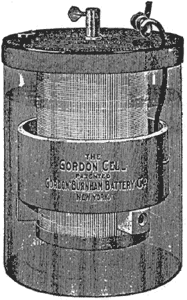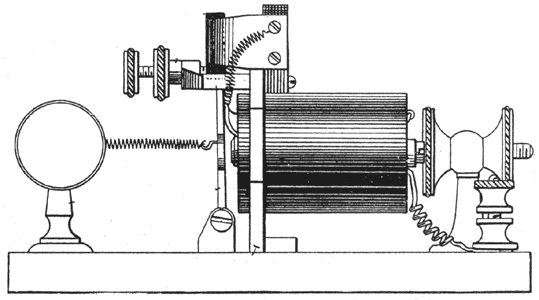[Trade Journal]
Publication: American Electrician
New York, NY, United States
vol. 10, no. 1, p. 45, col. 1-3
NEW
Apparatus
AND
Appliances.
·
·
GORDON PRIMARY BATTERY, AND BANKS
AUTOMATIC RESISTANCE INSERTER
The old form of blue-stone gravity battery was defective in so many respects that its use was limited to the special conditions of telegraphic work, where a high internal resistance and low-rate current were not objectionable. The new form of alkaline cell herewith illustrated possesses none of these disadvantages of the old type, and is claimed to be superior to other primary cells in that it cannot be polarized under the most severe closed-circuit work, a constant current being maintained until the elements of the cell are exhausted. Its commercial E. M. F. is from .65 to .75 volt under working conditions, and it has been known to hold its voltage until an output of 375 ampere-hours or 250 watt-hours have been drawn from the elements contained in a 6 in. X 8 in. jar.
 |
| Fig. 1 — Gordon Cell. |
The negative element consists of a perforated tin cylinder filled with black oxide of copper, which is a powerful depolarizing agent. Three porcelain lugs or cleats are attached to the lower part of the tin cylinder, upon which rests a rolled-zinc cylinder 5 1/2 ins. in diameter, 2 1/2 ins. wide, and containing 1 1/2 lbs. of chemically pure zinc amalgamated by a special process. The internal resistance of this cell is from .04 to .06 ohm. The solution used is an alkaline technically known as electro-sodium, which will not freeze or be chilled at winter temperatures as low as 25 to 30 degs. below zero, Fahr.
These cells are largely used in the telegraph and other services of the Federal Government, by various large railroads telephone and telegraph companies, and in the fire and police telegraph departments of a large number of cities.
 |
| Fig. 2 — Banks Automatic Resistance Inserter. |
When used in block-signal work, on account of the low internal resistance of the cell, the current is apt to be excessive when a train of cars is on the block. In order to overcome this objection, Mr. Banks, the electrician of the Gordon-Burnham Electric Battery Company, has perfected a device which automatically keeps down the current discharge to an amount necessary to work the signal service. This device is illustrated in Fig. 2. There are two coils, one a primary and the other a secondary. The primary is of low resistance and the secondary coil, which is normally cut out of circuit, and only cut in when a train comes into the block, is of the same resistance as the relay used under normal conditions for operating the signal circuit.
When a train comes into the block, an excessive current starts to flow through the primary coil, which attracts an armature and throws into series with the batteries the resistance of the secondary circuit, which remains there until the train runs off the block, upon which the armature falls back into its former position and thus throws again into circuit the primary coil.
The primary cell and Banks automatic resistance inserter above described, are manufactured by the Gordon-Burnham Battery Company, 82 West Broadway, New York.
·
·
